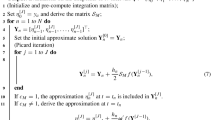Abstract
A parallel predictor-corrector (PC) iteration scheme for a general class of pseudo two-step Runge-Kutta methods (PTRK methods) of arbitrarily high order is analyzed for solving first-order nonstiff initial-value problems (IVPs) on parallel computers. Starting with ans-stage pseudo two-step RK method of orderp * withw implicit stages, we apply the highly parallel PC iteration process in P(EC)mE mode. The resulting parallel-iterated pseudo two-step RK method (PIPTRK method) uses an optimal number of processors equal tow. By a number of numerical experiments, we show the superiority of the PIPTRK methods proposed in this paper over both sequential and parallel methods available in the literature.
Similar content being viewed by others
References
K. Burrage, Efficient block predictor-corrector methods with a small number of corrections. J. Comput. Appl. Math.,45 (1993), 139–150.
K. Burrage, Parallel methods for initial value problems. Appl. Numer. Math.,11 (1993), 5–25.
K. Burrage, Parallel and Sequential Methods for Ordinary Differential Equations. Clarendon Press, Oxford, 1995.
K. Burrage and H. Suhartanto, Parallel iterated methods based on multistep Runge-Kutta mehods of Radau type. Advances in Computational Mathematics,7 (1997), 37–57.
J.C. Butcher, The Numerial Analysis of Ordinary Differential Equations, Runge-Kutta and General Linear Methods. Wiley, New York, 1987.
M.T. Chu and H. Hamilton, Parallel solution of ODEs by multi-block methods. SIAM J. Sci. Statist. Comput.,3 (1987), 342–353.
N.H. Cong, Parallel iteration of symmetric Runge-Kutta for nonstiff initial-value problems. J. Comput. Appl. Math.,51 (1994), 117–125.
N.H. Cong, Explicit pseudo two-step Runge-Kutta methods for parallel computers. Intern. J. Comput. Math.,73 (1999), 77–91.
N.H. Cong, Continuous variable stepsize explicit pseudo two-step RK methods. J. Comput. Appl. Math.,101 (1999), 105–116.
N.H. Cong, A general family of pseudo two-step Runge-Kutta methods. Southeast Asia Bull. Math.,25 (2001), 61–73.
N.H. Cong and T. Mitsui, Collocation-based two-step Runge-Kutta methods. Japan J. Indust. Appl. Math.,13 (1996), 171–183.
N.H. Cong and T. Mitsui, A class of explicit parallel two-step Runge-Kutta methods. Japan J. Indust. Appl. Math.,14 (1997), 303–313.
N.H. Cong, H. Podhaisky and R. Weiner, Numerical experiments with some explicit pseudo two-step RK methods on a shared memory computer. Comput. Math. Appl.,36 (1998), 107–116.
N.H. Cong and H.T. Vi, An improvement for explicit parallel Runge-Kutta methods. Vietnam J. Math.,23 (1995), 241–252.
A.R. Curtis, High-order explicit Runge-Kutta formulae, their uses and limitations. J. Inst. Math. Appl.,16 (1975), 35–55.
A.R. Curtis, Tables of Jacobian Elliptic Functions Whose Arguments are Rational Fractions of the Quarter Period. Her Majesty’s Stationary Office, London, 1964.
E. Hairer, A Runge-Kutta method of order 10. J. Inst. Math. Appl.,21 (1978), 47–59.
E. Hairer, S.P. Nørsett and G. Wanner, Solving Ordinary Differential Equations, I. Nonstiff Problems (2nd edition). Springer-Verlag, Berlin, 1993.
P.J. van der Houwen and N.H. Cong, Parallel block predictor-corrector methods of Runge-Kutta type. Appl. Numer. Math.,13 (1993), 109–123.
P.J. van der Houwen and B.P. Sommeijer, Parallel iteration of high-order Runge-Kutta methods with stepsize control. J. Comput. Appl. Math.,29 (1990), 111–127.
P.J. van der Houwen and B.P. Sommeijer, Block Runge-Kutta methods on parallel computers. Z. Angew. Math. Mech.,68 (1992), 3–10.
T.E. Hull, W.H. Enright, B.M. Fellen and A.E. Sedgwick, Comparing numerical methods for ordinary differential equations. SIAM J. Numer. Anal.,9 (1972), 603–637.
S.P. Nørsett and H.H. Simonsen, Aspects of parallel Runge-Kutta methods. Numerical Methods for Ordinary Differential Equations (eds. A. Bellen, C. W. Gear and E. Russo), Proceedings L’Aquilla 1987, Lecture Notes in Mathematics1386, Springer-Verlag, Berlin, 1989.
Author information
Authors and Affiliations
Additional information
This work was supported by Scientist Exchange Program FY2001 of JSPS.
About this article
Cite this article
Huu Cong, N., Mitsui, T. Parallel predictor-corrector iteration of pseudo two-step RK methods for nonstiff IVPs. Japan J. Indust. Appl. Math. 20, 51 (2003). https://doi.org/10.1007/BF03167462
Received:
Accepted:
DOI: https://doi.org/10.1007/BF03167462



